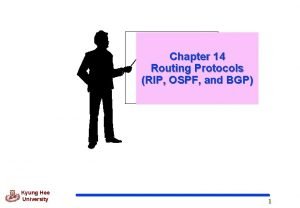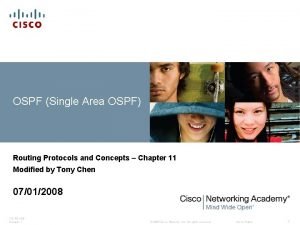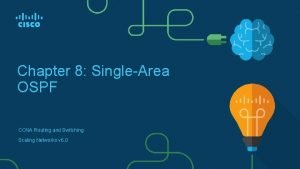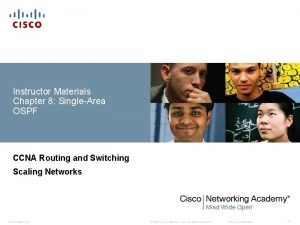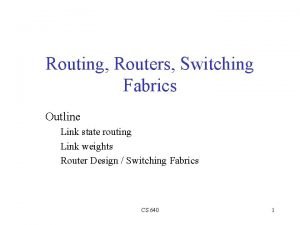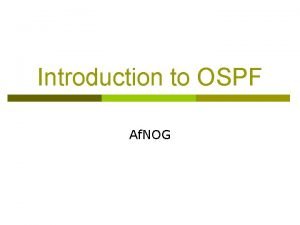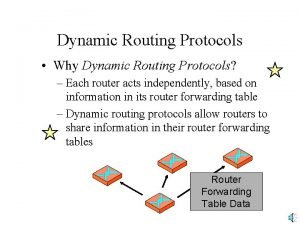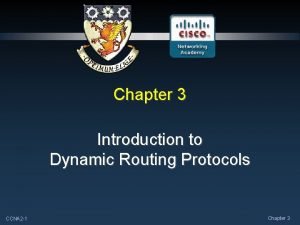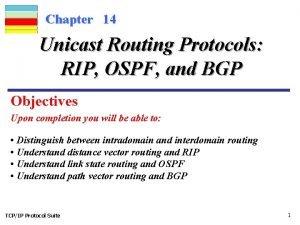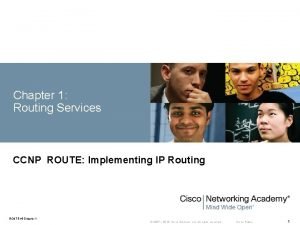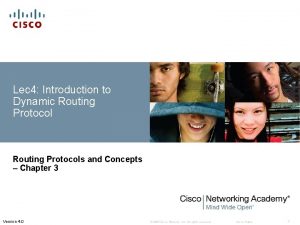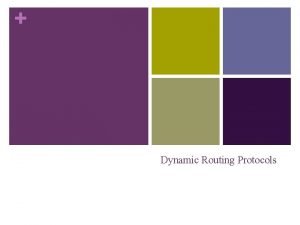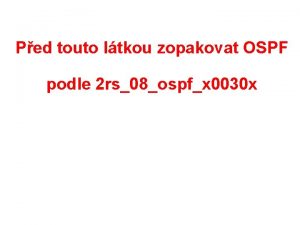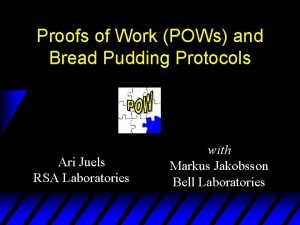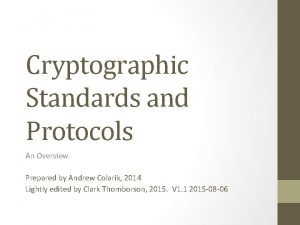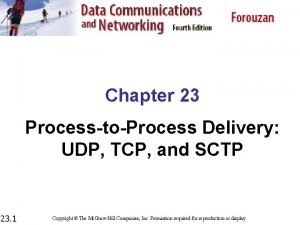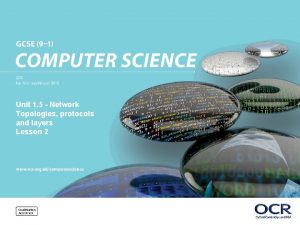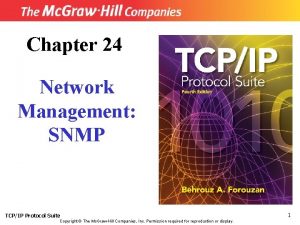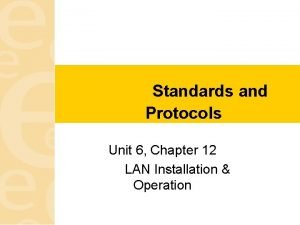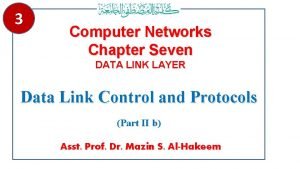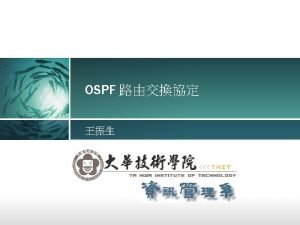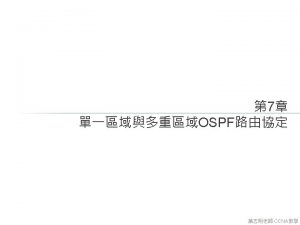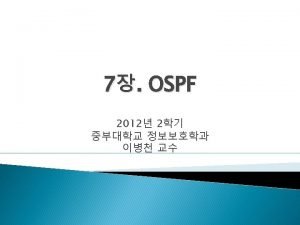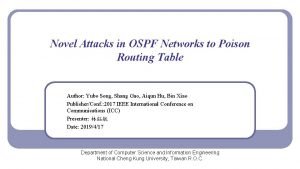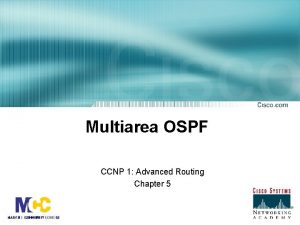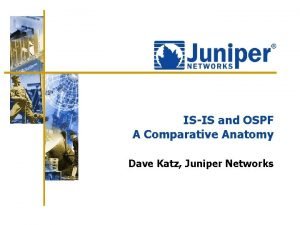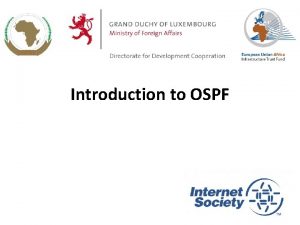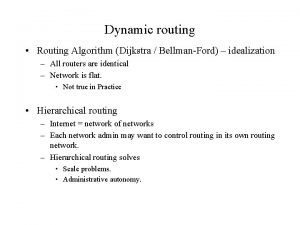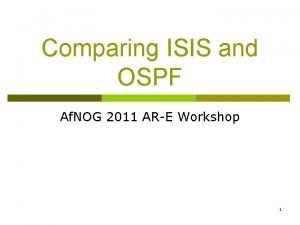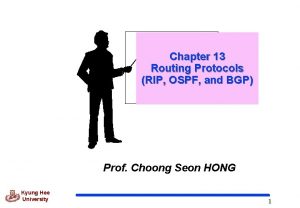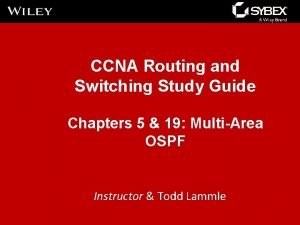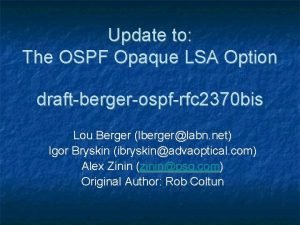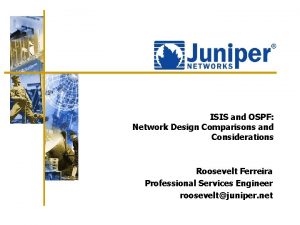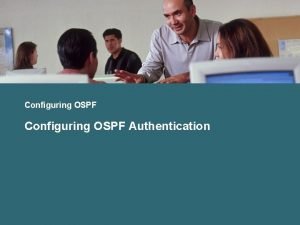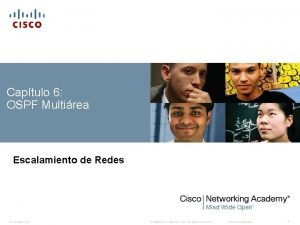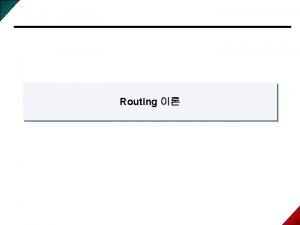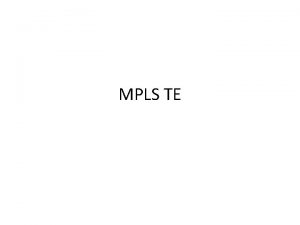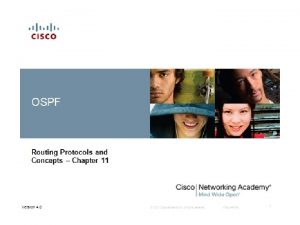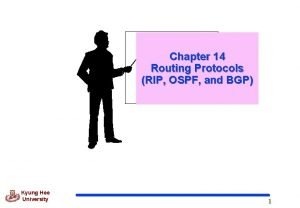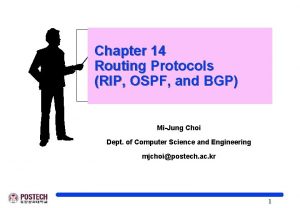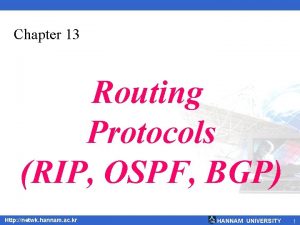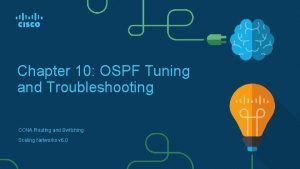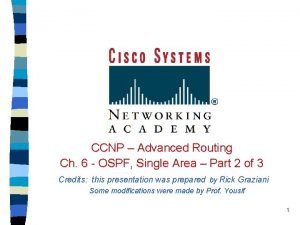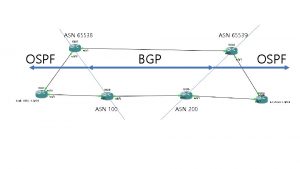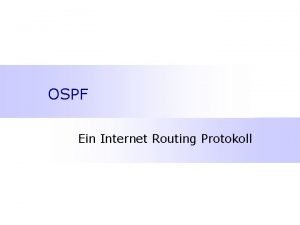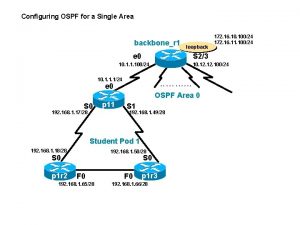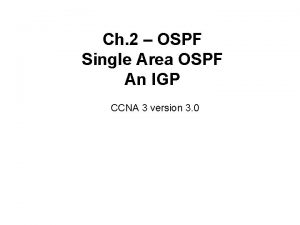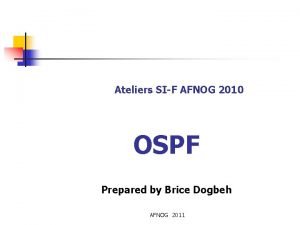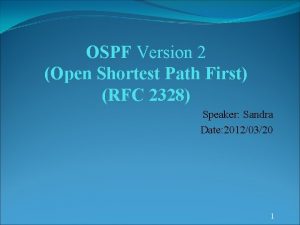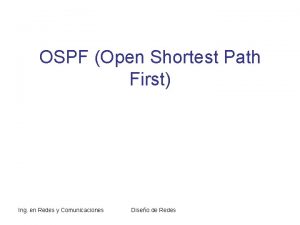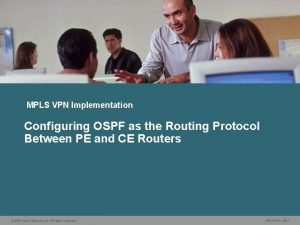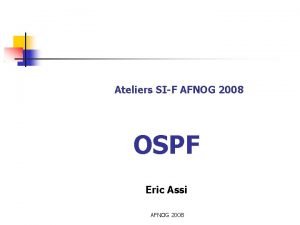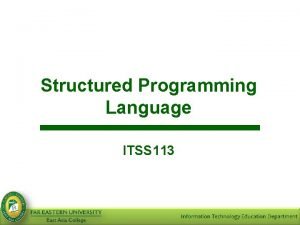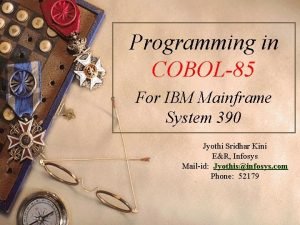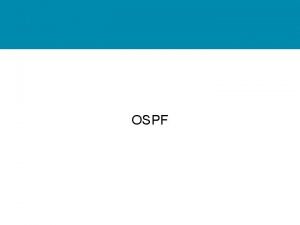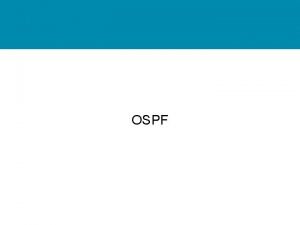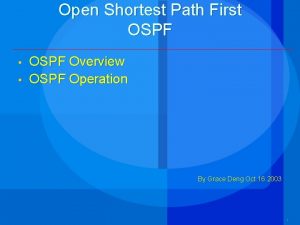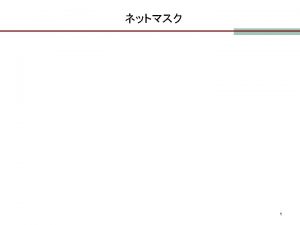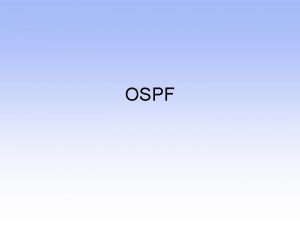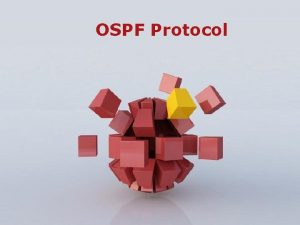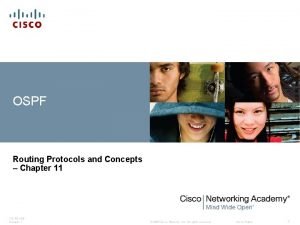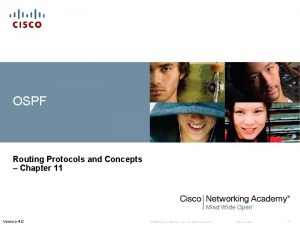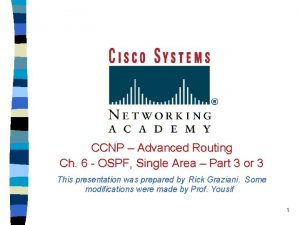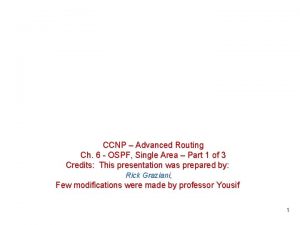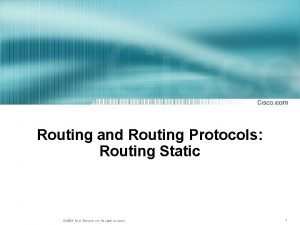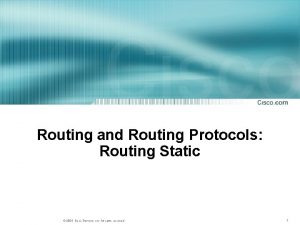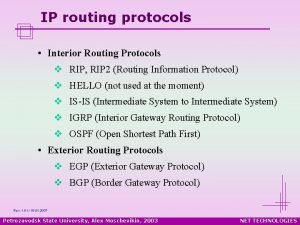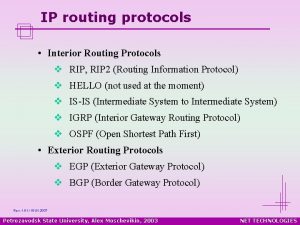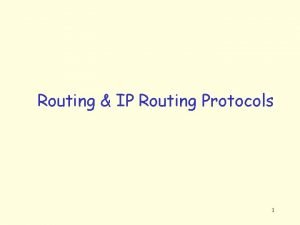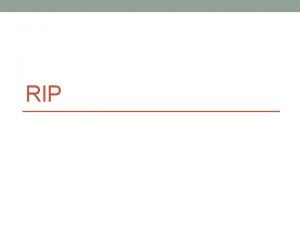OSPF Single Area OSPF Routing Protocols and Concepts








































































- Slides: 72

OSPF (Single Area OSPF) Routing Protocols and Concepts – Chapter 11 Modified by Tony Chen 07/01/2008 ITE PC v 4. 0 Chapter 1 © 2007 Cisco Systems, Inc. All rights reserved. Cisco Public 1

Notes: § If you see any mistake on my Power. Point slides or if you have any questions about the materials, please feel free to email me at chento@cod. edu. Thanks! Tony Chen College of Du. Page Cisco Networking Academy ITE PC v 4. 0 Chapter 1 © 2007 Cisco Systems, Inc. All rights reserved. Cisco Public 2

Introduction • In this chapter, you will learn basic, single-area OSPF implementations and configurations. • More complex OSPF configurations and concepts (multi-areas OSPF) are reserved for CCNP-level courses. ITE PC v 4. 0 Chapter 1 © 2007 Cisco Systems, Inc. All rights reserved. Cisco Public 3

Introduction to OSPF Background of OSPF § Began in 1987 § 1989 OSPFv 1 released in RFC 1131 This version was experimental & never deployed § 1991 OSPFv 2 released in RFC 1247 § 1998 OSPFv 2 updated in RFC 2328 § 1999 OSPFv 3 published in RFC 2740 ITE PC v 4. 0 Chapter 1 © 2007 Cisco Systems, Inc. All rights reserved. Cisco Public 4

Introduction to OSPF Message Encapsulation § OSPF packet type – There exist 5 types (next slide) § OSPF packet header –Contains - Router ID an area ID and Type code for OSPF packet type § IP packet header – Contains - Source IP address, Destination IP address, & Protocol field set to 89. the destination address is set to one of two multicast addresses: 224. 0. 0. 5 or 224. 0. 0. 6. § Data Link Frame Header –Contains - destination MAC address is also a multicast address: 01 -00 -5 E-00 -00 -05 or 01 -00 -5 E-00 -00 -06. ITE PC v 4. 0 Chapter 1 © 2007 Cisco Systems, Inc. All rights reserved. Cisco Public 5

Introduction to OSPF 5 OSPF Packet Types: § 1. Hello - Hello packets are used to establish and maintain adjacency with other OSPF routers. § 2. DBD - The Database Description (DBD) packet contains an abbreviated list of the sending router's link-state database and is used by receiving routers to check against the local link-state database. § 3. LSR - Receiving routers can then request more information about any entry in the DBD by sending a Link-State Request (LSR). § 4. LSU - Link-State Update (LSU) packets are used to reply to LSRs as well as to announce new information. –LSUs contain 7 different types of Link-State Advertisements (LSAs). –LSUs and LSAs are discussed in a later topic. § 5. LSAck - When an LSU is received, the router sends a Link-State Acknowledgement (LSAck) to confirm receipt of the LSU. ITE PC v 4. 0 Chapter 1 © 2007 Cisco Systems, Inc. All rights reserved. Cisco Public 6

OSPF: Hello Protocol § Purpose of Hello Packet § Discover OSPF neighbors & establish adjacencies § Advertise parameters on which routers must agree to become neighbors § Used by multi-access networks to elect a Designated Router and a Backup Designated Router ITE PC v 4. 0 Chapter 1 § Type: OSPF Packet Type: Hello (1), DD (2), LS Request (3), LS Update (4), LS ACK (5) § Router ID: ID of the originating router § Area ID: area from which the packet originated § Network Mask: Subnet mask associated with the sending interface § Hello Interval: number of seconds between the sending router's hellos § Router Priority: Used in DR/BDR election (discussed later) § Designated Router (DR): Router ID of the DR, if any § Backup Designated Router (BDR): Router ID of the BDR, if any § List of Neighbors: lists the OSPF Router ID of the neighboring router(s) © 2007 Cisco Systems, Inc. All rights reserved. Cisco Public 7

OSPF: Hello Protocol § Establish adjacencies: Also need to have the same Area ID. – They must agree on three values: Hello interval, Why 10 second hello interval Dead interval, and network type. communications consider better than § OSPF Hello Intervals the 30 second routing update for RIP? –Hello interval indicates how often an OSPF router transmits Hello packets –Usually multicast (224. 0. 0. 5) for ALLSPFRouters –sent every 10 seconds on multiaccess and point -to-point segments –Sent every 30 seconds for NBMA segments § OSPF Dead Intervals –This is the time that must transpire before the neighbor is considered down –Default time is 4 times the hello interval –For multiaccess and point-to-point segments, this period is 40 seconds. –For NBMA networks, the Dead interval is 120 seconds. –If the Dead interval expires before the routers receive a Hello packet, OSPF will remove that neighbor from its link-state database. ITE PC v 4. 0 Chapter 1 © 2007 Cisco Systems, Inc. All rights reserved. Cisco Public 8

OSPF: Hello Protocol § To reduce the amount of OSPF traffic on multiaccess networks, OSPF elects a Designated Router (DR) and Backup Designated Router (BDR). § Hello protocol packets contain information that is used in electing DR and BDR –The DR is responsible for updating all other OSPF routers (called DROthers) when a change occurs in the multiaccess network. –The BDR monitors the DR and takes over as DR if the current DR fails. § In the figure, R 1, R 2, and R 3 are connected through point-to-point links. Therefore, no DR/BDR election occurs. –The DR/BDR election and processes will be discussed in a later topic and the topology will be changed to a multiaccess network. ITE PC v 4. 0 Chapter 1 More detail discussion on the DR, BDR, DROther later. You need to know this for CCNA exam. © 2007 Cisco Systems, Inc. All rights reserved. Cisco Public 9

Introduction to OSPF Link-state Updates § Purpose of a Link State Update (LSU) –Used to deliver link state advertisements § Purpose of a Link State Advertisement (LSA) –Contains information about neighbors & path costs –An LSU packet can contain 11 different types of LSAs, ITE PC v 4. 0 Chapter 1 © 2007 Cisco Systems, Inc. All rights reserved. Cisco Public 10

Introduction to OSPF Algorithm § OSPF routers build & maintain link-state database containing LSA received from other routers 1. Information found in database is utilized upon execution of Dijkstra SPF algorithm 2. SPF algorithm used to create SPF tree 3. SPF tree used to populate routing table ITE PC v 4. 0 Chapter 1 © 2007 Cisco Systems, Inc. All rights reserved. Cisco Public 11

Introduction to OSPF Administrative Distance § Default Administrative Distance for OSPF is 110 ITE PC v 4. 0 Chapter 1 © 2007 Cisco Systems, Inc. All rights reserved. Cisco Public 12

Introduction to OSPF § OSPF Authentication –It is good practice to authenticate transmitted routing information. –This is an interface specific configuration –This practice ensures that routers will only accept routing information from other routers that have been configured with the same password or authentication information MD 5 authentication uses a key ID that allows the router to reference multiple passwords, making password migration easier and more secure. Note: Authentication does not encrypt the router's routing table. ? ITE PC v 4. 0 Chapter 1 © 2007 Cisco Systems, Inc. All rights reserved. Cisco Public 13

Basic OSPF Configuration Lab Topology § Topology used for this chapter –Discontiguous IP addressing scheme –Since OSPF is a classless routing protocol the subnet mask is will be configured as part of our OSPF configuration. ITE PC v 4. 0 Chapter 1 © 2007 Cisco Systems, Inc. All rights reserved. Cisco Public 14

Basic OSPF Configuration The router ospf command § To enable OSPF on a router use the following command R 1(config)#router ospf process-id ID cannot be 0 Process id § A locally significant number between 1 and 65535 ITE PC v 4. 0 Chapter 1 © 2007 Cisco Systems, Inc. All rights reserved. Cisco Public 15

Basic OSPF Configuration § OSPF network command –Requires entering: • network address • wildcard mask - the inverse of the subnet mask • area-id - area-id refers to the OSPF area is a group of routers that share link state information Router(config-router)#network-address wildcard-ask area-id 255 Subtract the - 255. 240 subnet mask ----------Wildcard mask 0. 0. 0. 15 255 Subtract the - 255. 252 subnet mask ----------Wildcard mask 0. 03 ITE PC v 4. 0 Chapter 1 © 2007 Cisco Systems, Inc. All rights reserved. Cisco Public 16

Basic OSPF Configuration § Cisco IOS now properly handles overlapping network. . . area configuration commands. § Consider the following example: fw#conf t Enter configuration commands, one per line. End with CNTL/Z. fw(config)#router ospf 100 fw(config-router)#network 0. 0 255 area 0 fw(config-router)#network 10. 0. 3. 255 area 1 13: 06: 57: %OSPF-6 -AREACHG: 10. 0 255. 252. 0 changed from area 0 to area 1 fw(config-router)#network 10. 0. 7 area 2 13: 07: 10: %OSPF-6 -AREACHG: 10. 0 255. 248 changed from area 1 to area 2 fw(config-router)#^Z § I've entered overlapping network statements, each one with a smaller address range. Not only does IOS detect that they overlap, it also prints nice syslog messages and reorders the commands in the running configuration. Well done ! fw#show run | begin router ospf 100 log-adjacency-changes network 10. 0. 7 area 2 network 10. 0. 3. 255 area 1 network 0. 0 255 area 0 ITE PC v 4. 0 Chapter 1 http: //blog. ioshints. info/2006/11/ network-statements-in-ospfprocess-are. html © 2007 Cisco Systems, Inc. All rights reserved. Cisco Public 17

Basic OSPF Configuration § ospf network definition for adding all interfaces / default route What’s the difference? router ospf 1 network 0. 0 area 0 vs. router ospf 1 network 0. 0 255 area 0 § Both add all existing interfaces into area 0 and all later added interfaces also. Both statements are valid. http: //blog. sazza. de/? p=427 ITE PC v 4. 0 Chapter 1 © 2007 Cisco Systems, Inc. All rights reserved. Cisco Public 18

Basic OSPF Configuration § Area area-id §An OSPF area is a group of routers that share link-state information. § In this chapter, we will configure all of the OSPF routers within a single area. This is known as single-area OSPF. §Multi-area OSPF is covered in CCNP. ITE PC v 4. 0 Chapter 1 © 2007 Cisco Systems, Inc. All rights reserved. Cisco Public 19

Basic OSPF Configuration § Router ID – This is an IP address used to identify a router – 3 criteria for deriving the router ID 1. Use IP address configured with OSPF router-id command -Takes precedence over loopback and physical interface addresses 2. If router-id command not used then router chooses highest IP address of any loopback interfaces 3. If no loopback interfaces are configured then the highest IP address on any active physical interface is used § The interface does not need to be enabled for OSPF, meaning that it does not need to be included in one of the OSPF network commands. § However, the interface must be active - it must be in the up state. ITE PC v 4. 0 Chapter 1 However!!!!!! © 2007 Cisco Systems, Inc. All rights reserved. Cisco Public 20

Basic OSPF Configuration § Router ID – If you are the king when the kingdom is built, you are the KING for life – It means when ID is elected, it is the ID for the router, unless …………. . ITE PC v 4. 0 Chapter 1 © 2007 Cisco Systems, Inc. All rights reserved. Cisco Public 21

Basic OSPF Configuration OSPF Router ID § Commands used to verify current router ID –Show ip protocols –Show ip ospf interface ITE PC v 4. 0 Chapter 1 © 2007 Cisco Systems, Inc. All rights reserved. Cisco Public 22

Basic OSPF Configuration OSPF Router ID § Router ID (not configured) & Loopback addresses (configured) –Highest loopback address will be used as router ID –Advantage of using loopback address the loopback interface cannot fail OSPF stability § The OSPF router-id command –Introduced in IOS 12. 0 –OSPF router-id command, which is a fairly recent addition to IOS, it is more common to find loopback addresses used for configuring OSPF router IDs. –Command syntax §Router(config)#router ospf process-id §Router(config-router)#router-id ip-address § Modifying the Router ID –Use the command Router#clear ip ospf process This command does not work in PT. ITE PC v 4. 0 Chapter 1 © 2007 Cisco Systems, Inc. All rights reserved. Cisco Public 23

Basic OSPF Configuration Modifying the Router ID § The router ID is selected when OSPF is configured with its first OSPF network command. – If the OSPF router-id command or the loopback address is configured after the OSPF network command, the router ID will be derived from the interface with the highest active IP address. § Modifying the Router ID The router ID can be modified with 1. the IP address from a subsequent OSPF router-id command by reloading the router or 2. by using the following command: Router#clear ip ospf process 3. Modifying a router ID with a new loopback or physical interface IP address may require reloading the router ITE PC v 4. 0 Chapter 1 © 2007 Cisco Systems, Inc. All rights reserved. Cisco Public 24

Basic OSPF Configuration Duplicate Router IDs § When two routers have the same router ID in an OSPF domain, routing may not function properly. – If the router ID is the same on two neighboring routers, the neighbor establishment may not occur. § When duplicate OSPF router IDs occur, IOS will display a message similar to: – %OSPF-4 -DUP_RTRID 1: Detected router with duplicate router ID § To correct this problem, configure all routers so that they have unique OSPF router IDs. Ø Because some IOS versions do not support the router-id command, we will use the loopback address method for assigning router IDs. ITE PC v 4. 0 Chapter 1 © 2007 Cisco Systems, Inc. All rights reserved. Cisco Public 25

Quick Review We just went over 3 different types of ID § ospf process-id. – OSPF process. – Cannot be 0 § Area ID: – OFPS area – If it is the first, and the backbone area, it is 0 § Router ID – 1 IP address is elected per router, • Highest physical address (or) • Highest logical address (loopback) ITE PC v 4. 0 Chapter 1 © 2007 Cisco Systems, Inc. All rights reserved. Cisco Public 26

Basic OSPF Configuration Verifying OSPF § Use the show ip ospf command to verify & trouble shoot OSPF networks: § Neighbor adjacency §Adjacency indicated by §The OSPF state of the interface is “full state” §No adjacency indicated by - §Neighboring router’s Router ID is not displayed §A state of full is not displayed -Consequence of no adjacency- • Neighbor ID - The router ID of the neighboring router. • Pri - The OSPF priority of the interface. . • State - The OSPF state of the interface. FULL state means that the router and its neighbor have identical OSPF link-state databases. • Dead Time - The amount of time remaining that the router will wait to receive an OSPF Hello packet from the neighbor before declaring the neighbor down. This value is reset when the interface receives a Hello packet. • Address - The IP address of the neighbor's interface to which this router is directly connected. • Interface - The interface on which this router has formed adjacency with the neighbor. 27 © 2007 Cisco Systems, Inc. All rights reserved. Cisco Public §No link state information exchanged §Inaccurate SPF trees & routing tables ITE PC v 4. 0 Chapter 1

Basic OSPF Configuration Note: § On multiaccess networks such as Ethernet, two routers that are adjacent may have their states displayed as 2 WAY. –This will be discussed in a DR and BDR section. § Two routers may not form an OSPF adjacency if: –The subnet masks do not match, causing the routers to be on separate networks. • Neighbor ID - The router ID of the neighboring router. • Pri - The OSPF priority of the interface. . • State - The OSPF state of the interface. FULL state means that the router and its neighbor have identical OSPF link-state databases. • Dead Time - The amount of time remaining that the router will wait to receive an OSPF Hello packet from the neighbor before declaring the neighbor down. This value is reset when the interface receives a Hello packet. • Address - The IP address of the neighbor's interface to which this router is directly connected. • Interface - The interface on which this router has formed adjacency with the neighbor. 28 © 2007 Cisco Systems, Inc. All rights reserved. Cisco Public –OSPF Hello or Dead Timers do not match. –OSPF Network Types do not match. –There is a missing or incorrect OSPF network command. ITE PC v 4. 0 Chapter 1

Verifying OSPF § Show ip protocols –OSPF process ID, –the router ID, –networks the router is advertising, –the default administrative distance, 110 for OSPF. § Show ip ospf –OSPF process ID –router ID. –OSPF area information –the last time the SPF algorithm was calculated. • R 1 has participated in during the past 11 and a half hours is to send small Hello packets to its neighbors. –SPF schedule delay • The router waits 5000 msecs after receiving an LSU before running the SPF algorithm. • There is an additional Hold Time of 10000 msecs between 2 SPF calculations. § Show ip ospf interface –The quickest way to verify Hello and Dead intervals • for OSPF routers to become neighbors, their OSPF Hello and Dead intervals must be identical. ITE PC v 4. 0 Chapter 1 © 2007 Cisco Systems, Inc. All rights reserved. Cisco Public 29

Configuring OSPF loopback address and router priority The command show ip ospf interface will display the interface priority value as well as other key information. ITE PC v 4. 0 Chapter 1 © 2007 Cisco Systems, Inc. All rights reserved. Cisco Public 30

Basic OSPF Configuration Examining the routing table § Use the show ip route command to display the routing table -An “O’ at the beginning of a route indicates that the router source is OSPF -OSPF does not automatically summarize at major network boundaries • Loopback interface counts as a network. • These loopback interfaces are not advertised in OSPF. • They function as router ID. ITE PC v 4. 0 Chapter 1 © 2007 Cisco Systems, Inc. All rights reserved. Cisco Public 31

OSPF Metric § OSPF uses cost as the metric for determining the best route –A cost is associated with the output side of each router interface. –The lower the cost, the more likely the interface is to be used to forward data traffic § The Cisco IOS uses the cumulative bandwidths of the outgoing interfaces from the router to the destination network as the cost value. -Cost is based on bandwidth of an interface §Cost is calculated using the formula 108 / bandwidth -Reference bandwidth §The 100 Mbps (Fast. Ethernet) and higher will have the same OSPF cost of 1. §This reference bandwidth can be modified using §auto-cost reference-bandwidth command ITE PC v 4. 0 Chapter 1 © 2007 Cisco Systems, Inc. All rights reserved. Cisco Public 32

OSPF Metric § COST of an OSPF route is the accumulated value from one router to the destination network • For example, in the figure, the routing table on R 1 shows a cost of 65 to reach the 10. 10. 0/24 network on R 2. • Because 10. 10. 0/24 is attached to a Fast. Ethernet interface, R 2 assigns the value 1 as the cost for 10. 10. 0/24. • R 1 then adds the additional cost value of 64 to send data across the default T 1 link between R 1 and R 2. ITE PC v 4. 0 Chapter 1 64 + 1 = 65 © 2007 Cisco Systems, Inc. All rights reserved. Cisco Public 33

OSPF Metric § Sometimes the actual speed of a link is different than the default bandwidth –This makes it imperative that the bandwidth value reflects link’s actual speed §Reason: so routing table has best path information § The show interface command will display interface’s bandwidth –Most serial link default to 1. 544 Mbps –However, some serial interfaces may default to 128 kbps. ITE PC v 4. 0 Chapter 1 © 2007 Cisco Systems, Inc. All rights reserved. Cisco Public 34

Modifying OSPF cost metric § OSPF uses cost as the metric for determining the best route. Cost is calculated using the formula 108/bandwidth, where bandwidth is expressed in bps. (Cost = 100, 000/Bandwidth) § The Cisco IOS automatically determines cost based on the bandwidth of the interface. § It is essential for proper OSPF operation that the correct interface bandwidth is set. Router(config)#interface serial 0/0 Router(config-if)#bandwidth 64 The default bandwidth for Cisco serial interfaces is 1. 544 Mbps, or 1544 kbps. 2 A/S ITE PC v 4. 0 Chapter 1 2 T © 2007 Cisco Systems, Inc. All rights reserved. COD has these 2 types of serial cards in the lab Cisco Public 35

OSPF Metric: Bandwidth § Remember, this bandwidth value does not actually affect the speed of the link; it is used by some routing protocols to compute the routing metric. –It is important that the bandwidth value reflect the actual speed of the link so that the routing table has accurate best path information. § The figure displays the routing table for R 1. –R 1 believes that both of its serial interfaces are connected to T 1 links, • one of the links is a 64 kbps link • the other one is a 256 kbps link. –This results in R 1's routing table having two equal-cost paths to the 192. 168. 8. 0/30 network, when Serial 0/0/1 is actually the better path. How to modify the cost of all the links? ITE PC v 4. 0 Chapter 1 © 2007 Cisco Systems, Inc. All rights reserved. Cisco Public 36

Basic OSPF Configuration Modifying the Cost of a link § Both sides of a serial link should be configured with the same bandwidth –Commands used to modify bandwidth value §Bandwidth command –Example: Router(config-if)#bandwidth-kbps §ip ospf cost command – allows you to directly specify interface cost -Example: R 1(config)#interface serial 0/0/0 R 1(config-if)#ip ospf cost 1562 ITE PC v 4. 0 Chapter 1 © 2007 Cisco Systems, Inc. All rights reserved. Cisco Public 37

Modifying the Cost of the link § Difference between bandwidth command & the ip ospf cost command –Ip ospf cost command §Sets cost to a specific value –Bandwidth command §Link cost is calculated ITE PC v 4. 0 Chapter 1 © 2007 Cisco Systems, Inc. All rights reserved. Cisco Public 38

OSPF and Multiaccess Networks Challenges in Multiaccess Networks § OSPF defines five network types: –Point-to-point • network there are only two devices on the network, one at each end. –Broadcast Multiaccess • a network with more than two devices on the same shared media. • all devices on the network see all broadcast frames. –Nonbroadcast Multiaccess (NBMA) • networks include Frame Relay, ATM, and X. 25 networks. –Point-to-multipoint • networks include Frame Relay, ATM, and X. 25 networks. –Virtual links • Virtual links are a special type of link that can be used in multi-area OSPF. ITE PC v 4. 0 Chapter 1 © 2007 Cisco Systems, Inc. All rights reserved. Cisco Public 39

OSPF in Multiaccess Networks § 2 challenges presented by multiaccess networks –Multiple adjacencies –Extensive LSA flooding § The creation of an adjacency between every pair of routers in a network would create an unnecessary number of adjacencies. –This would lead to an excessive number of LSAs passing between routers on the same network. • 5 routers in the figure will need 10 adjacencies, • 10 routers would require 45 adjacencies. • 20 routers would require 190 adjacencies ITE PC v 4. 0 Chapter 1 © 2007 Cisco Systems, Inc. All rights reserved. Cisco Public 40

OSPF in Multiaccess Networks § Extensive flooding of LSAs For every LSA sent out there must be an acknowledgement of receipt sent back to transmitting router. consequence: lots of bandwidth consumed and chaotic traffic Solution: ITE PC v 4. 0 Chapter 1 © 2007 Cisco Systems, Inc. All rights reserved. Cisco Public 41

Steps in the operation of OSPF § OSPF routers send Hello packets on OSPF enabled interfaces. § On multi-access networks, the routers elect a DR and BDR. On these networks other routers become adjacent to the DR. To reduce the number of adjacencies traffics To reduce the number of adjacencies each router must form, OSPF calls one of the routers the designated router. A designated router is elected as routers are forming adjacencies, and then all other routers establish adjacencies only with the designated router. This simplifies the routing table update procedure and reduces the number of link-state records in the database. The designated router plays other important roles as well to reduce the overhead of a OSPF link-state procedures. For example, other routers send link-state advertisements it to the designated router only by using the all-designated-routers multicast address of 224. 0. 0. 6. http: //www. chebucto. ns. ca/Chebucto/Technical/M anuals/Max/max 6000/isptele/maxospf. htm ITE PC v 4. 0 Chapter 1 © 2007 Cisco Systems, Inc. All rights reserved. Cisco Public 42

Steps in the operation of OSPF § OSPF routers send Hello packets on OSPF enabled interfaces. § On multi-access networks, the routers elect a DR and BDR. On these networks other routers become adjacent to the DR. ITE PC v 4. 0 Chapter 1 © 2007 Cisco Systems, Inc. All rights reserved. Cisco Public 43

Steps in the operation of OSPF § To reduce the number of adjacencies traffics http: //www. cisco. com/warp/public/104/11. html ITE PC v 4. 0 Chapter 1 © 2007 Cisco Systems, Inc. All rights reserved. Cisco Public 44

OSPF in Multiaccess Networks § Solution to LSA flooding issue is the use of –Designated router (DR) –Backup designated router (BDR) • this solution is analogous to electing someone in the room to go around and learn everyone's names and then announce these names to everyone in the room at once. –DROther • All other routers become DROthers (this indicates a router that is neither the DR or the BDR). • DROthers only form full adjacencies with the DR and BDR in the network. § DR & BDR –On multiaccess networks, OSPF elects a Designated Router (DR) to be the collection and distribution point for LSAs sent and received. –A Backup Designated Router (BDR) is also elected in case the Designated Router fails. –DR & BDR are elected to send & receive LSA ITE PC v 4. 0 Chapter 1 © 2007 Cisco Systems, Inc. All rights reserved. Cisco Public 45

OSPF in Multiaccess Networks § DR & BDR & DROther –Routers on a multiaccess network elect a DR and BDR. –DR & BDR are elected to send & receive LSA –DROthers only form full adjacencies with the DR and BDR in the network. § Sending & Receiving LSA –DRothers send LSAs via multicast 224. 0. 0. 6 to DR & BDR (ALLDRouters - All DR routers) –DR forward LSA via multicast address 224. 0. 0. 5 to all other routers (All. SPFRouters - All OSPF routers). ITE PC v 4. 0 Chapter 1 © 2007 Cisco Systems, Inc. All rights reserved. Cisco Public 46

OSPF in Multiaccess Networks DR/BDR Election Process § DR/BDR elections DO NOT occur in point-topoint networks ITE PC v 4. 0 Chapter 1 § DR/BDR elections will take place on multiaccess networks as shown below © 2007 Cisco Systems, Inc. All rights reserved. Cisco Public 47

OSPF in Multiaccess Networks § Criteria for getting elected DR/BDR 1. DR: Router with the highest OSPF interface priority. 2. BDR: Router with the second highest OSPF interface priority. 3. If OSPF interface priorities are equal, the highest router ID is used to break the tie. ITE PC v 4. 0 Chapter 1 © 2007 Cisco Systems, Inc. All rights reserved. Cisco Public 48

§ Criteria for getting elected DR/BDR 1. DR: Router with the highest OSPF interface priority. 2. BDR: Router with the second highest OSPF interface priority. 3. If OSPF interface priorities are equal, the highest router ID is used to break the tie. § Example: – The OSPF for all interface priority is 1. – The OSPF router ID is used to elect the DR and BDR. • Router. C with the highest router ID, becomes the DR • Router. B, with the second highest router ID, becomes the BDR. • Because Router. A is not elected as either the DR or BDR, it becomes the DROthers only form FULL adjacencies with the DR and BDR, but will still form a neighbor adjacency with any DROthers that join the network. When two DROther routers form a neighbor adjacency, the neighbor state is ITE PC v 4. 0 displayed as 2 WAY. Chapter 1 © 2007 Cisco Systems, Inc. All rights reserved. You need 4 routers topology to see this “ 2 way” adjacency. Cisco Public 49

OSPF network types (cont. ) Real DR and BDR election process The first router up on the network is the DR. The second router up on the network is the BDR. If the DR fails then the BDR becomes DR and another router is elected the BDR. The DR does not change just because another router comes on line with a higher priority or a higher router id. If both the existing DR and BDR fail and a new DR must be elected, the router with the highest priority is elected DR. If there's a tie, the router with the highest router id is elected DR. ITE PC v 4. 0 Chapter 1 © 2007 Cisco Systems, Inc. All rights reserved. Cisco Public 50

Timing of DR/BDR Election (This is really of how the election works) § Election occurs as soon as 1 st router has its OSPF enabled on multiaccess network. This can happen when 1. When the routers are powered-on • it is possible that a router with a lower router ID will become the DR. This could be a lower-end router that took less time to boot. 2. when the OSPF network command for that interface is configured. § When a DR is elected it remains as the DR until one of the following occurs -The DR fails. -The OSPF process on the DR fails. -The multiaccess interface on the DR fails. ITE PC v 4. 0 Chapter 1 © 2007 Cisco Systems, Inc. All rights reserved. Cisco Public 51

Timing of DR/BDR Election (This is really of how the election works) § DR Fails –If the DR fails, the BDR assumes the role of DR and an election is held to choose a new BDR. –In the figure, Router. C fails and the former BDR, Router. B, becomes DR. The only other router available to be BDR is Router. A. ITE PC v 4. 0 Chapter 1 © 2007 Cisco Systems, Inc. All rights reserved. Cisco Public 52

Timing of DR/BDR Election (This is really of how the election works) § New Router –If a new router enters the network after the DR and BDR have been elected, it will not become the DR or the BDR even if it has a higher OSPF interface priority or router ID than the current DR or BDR. • If the current DR fails, the BDR will become the DR, and the new router can be elected the new BDR. • After the new router becomes the BDR, if the DR fails, then the new router will become the DR. • The current DR and BDR must both fail before the new router can be elected DR or BDR. ITE PC v 4. 0 Chapter 1 © 2007 Cisco Systems, Inc. All rights reserved. Cisco Public 53

Timing of DR/BDR Election (This is really of how the election works) § Old DR Returns –A previous DR does not regain DR status if it returns to the network. • In the figure, Router. C has finished a reboot and becomes a DROther even though its router ID, 192. 168. 31. 33, is higher than the current DR and BDR. ITE PC v 4. 0 Chapter 1 © 2007 Cisco Systems, Inc. All rights reserved. Cisco Public 54

Timing of DR/BDR Election (This is really of how the election works) § BDR Fails –If the BDR fails, an election is held among the DRothers to see which router will be the new BDR. • In the figure, the BDR router fails. • An election is held between Router. C and Router. D. • Router. D wins the election with the higher router ID. ITE PC v 4. 0 Chapter 1 © 2007 Cisco Systems, Inc. All rights reserved. Cisco Public 55

Timing of DR/BDR Election (This is really of how the election works) § New DR Fails –In the figure, Router. B fails. Because Router. D is the current BDR, it is promoted to DR. Router. C becomes the BDR. § So, how do you make sure that the routers you want to be DR and BDR win the election? Without further configurations, the solution is to either: –Boot up the DR first, followed by the BDR, and then boot all other routers, or –Shut down the interface on all routers, followed by a no shutdown on the DR, then the BDR, and then all other routers. OR: use the priority command set not desired DR and BDR to 0 ITE PC v 4. 0 Chapter 1 © 2007 Cisco Systems, Inc. All rights reserved. Cisco Public 56

OSPF in Multiaccess Networks OSPF Interface Priority § Manipulating the DR/BDR election process continued –Use the ip ospf priority interface command. –Example: Router(config-if)#ip ospf priority {0 - 255} §Priority number range 0 to 255 – 0 means the router cannot become the DR or BDR – 1 is the default priority value » router ID determined the DR and BDR ITE PC v 4. 0 Chapter 1 © 2007 Cisco Systems, Inc. All rights reserved. Cisco Public 57

OSPF in Multiaccess Networks OSPF Interface Priority § Modify Priority –Router(config-if)#ip ospf priority {0 - 255} § Force Election –After doing a shutdown and a no shutdown on the Fast. Ethernet 0/0 interfaces of all three routers, we see the result of the change of OSPF interface priorities. –The show ip ospf neighbor command on Router. C now shows that Router. A (Router ID 192. 168. 31. 11) is the DR with the highest OSPF interface priority of 200 –Router. B (Router ID 192. 168. 31. 22) is still the BDR with the next highest OSPF interface priority of 100. –Notice from Router. A's output of show ip ospf neighbor that it does not show a DR, because Router. A is the actual DR on this network. ITE PC v 4. 0 Chapter 1 © 2007 Cisco Systems, Inc. All rights reserved. DR BDR Cisco Public 58

More OSPF Configuration Redistributing an OSPF Default Route § Topology includes a link to ISP –Router connected to ISP §Called an autonomous system border router In this topology, the Loopback 1 (Lo 1) simulate the connection to another §Used to propagate a default router. –Example of static default route R 1(config)#ip route 0. 0 loopback 1 –Requires the use of the default-information originate command –Example of default-information originate command R 1(config-router)#default-information originate ITE PC v 4. 0 Chapter 1 © 2007 Cisco Systems, Inc. All rights reserved. Cisco Public 59

Redistributing an OSPF Default Route The default route in R 2 and R 3 with the routing source OSPF, but with the additional code, E 2. For R 2, the route is: O*E 2 0. 0/0 [110/1] via 192. 168. 10, 00: 05: 34, Serial 0/0/1 E 2 denotes that this route is an OSPF External Type 2 route. the cost of an E 2 route is always the external cost, irrespective of the interior cost to reach that route. (CCNP) ITE PC v 4. 0 Chapter 1 © 2007 Cisco Systems, Inc. All rights reserved. Cisco Public 60

More OSPF Configuration Fine-Tuning OSPF § Since link speeds are getting faster it may be necessary to change reference bandwidth values –Do this using the auto-cost reference-bandwidth command –Example: § R 1(config-router)#auto-cost reference-bandwidth 10000 • the default value is equivalent to 100. To increase it to 10 Gig. E speeds, you would need to change the reference bandwidth to 10000. • Again, make sure you configure this command on all routers in the OSPF routing domain. ITE PC v 4. 0 Chapter 1 © 2007 Cisco Systems, Inc. All rights reserved. Cisco Public 61

More OSPF Configuration Fine-Tuning OSPF § R 1(config-router)#auto-cost reference-bandwidth 10000 • the default value is equivalent to 100. To increase it to 10 Gig. E speeds, you would need to change the reference bandwidth to 10000. R 1 Before, the cost to 10. 10. 0/24 is 1172. After configuring a new reference bandwidth, the cost for the same route is now 117287. ITE PC v 4. 0 Chapter 1 © 2007 Cisco Systems, Inc. All rights reserved. Cisco Public 62

More OSPF Configuration Fine-Tuning OSPF § Modifying OSPF timers –Reason to modify timers §Faster detection of network failures –Manually modifying Hello & Dead intervals §Router(config-if)#ip ospf hello-interval seconds §Router(config-if)#ip ospf dead-interval seconds –Point to be made §Hello & Dead intervals must be the same between neighbors ITE PC v 4. 0 Chapter 1 © 2007 Cisco Systems, Inc. All rights reserved. Cisco Public 63

The End § Questions? What will be the result of the DR and BDR elections for this single area OSPF network? (Choose three. ) *. Decision process: HQ will be DR for 10. 4. 0. 0/16. Router A will be DR for 10. 4. 0. 0/16. HQ will be BDR for 10. 4. 0. 0/16. Router A will be DR for 10. 5. 0. 0/16. Remote will be BDR for 10. 5. 0. 0/16. ITE PC v 4. 0 Chapter 1 1. Which segment will have election? 2. Priority? 3. Router ID (each router will only has 1 ID)? 1. Set using “router-ID” command 2. Highest Loopback IP address? 3. Highest physical IP address (include serial interface)? © 2007 Cisco Systems, Inc. All rights reserved. Cisco Public 64

The End § Questions? The routers in the diagram are configured as shown. The loopback interface on router R 1 is labeled as lo 0. All OSPF priorities are set to the default except for Ethernet 0 of router R 2, which has an OSPF priority of 2. What will be the result of the OSPF DR/BDR elections on the 192. 1. 1. 0 network? (Choose two. ) R 1 will be the DR R 1 will be the BDR R 2 will be the DR ITE PC v 4. 0 Chapter 1 *. Decision process: 1. Which segment will have election? 2. Priority? 3. Router ID (each router will only has 1 ID)? R 2 will be the BDR 1. Set using “router-ID” command R 3 will be the DR 2. Highest Loopback IP address? R 3 will be the BDR 3. Highest physical IP address (include serial interface)? © 2007 Cisco Systems, Inc. All rights reserved. Cisco Public 65

§ Questions? *. Decision process: ITE PC v 4. 0 Chapter 1 1. Which segment will have election? 2. Priority? 3. Router ID (each router will only has 1 ID)? 1. Set using “router-ID” command 2. Highest Loopback IP address? 3. Highest physical IP address (include serial interface)? © 2007 Cisco Systems, Inc. All rights reserved. Cisco Public 66

§ Questions? Answer? ? ? *. Decision process: ITE PC v 4. 0 Chapter 1 1. Which segment will have election? 2. Priority? 3. Router ID (each router will only has 1 ID)? 1. Set using “router-ID” command 2. Highest Loopback IP address? 3. Highest physical IP address (include serial interface)? © 2007 Cisco Systems, Inc. All rights reserved. Cisco Public 67

§ Questions? Answer? ? ? § HQ will be DR for 10. 4. 0. 0/16 § Router A will be DR for 10. 4. 0. 0/16. § HQ will be BDR for 10. 4. 0. 0/16. *. Decision process: § Router A will be DR for 10. 5. 0. 0/16 1. Which segment will have election? 2. Priority? § Remote will be DR for 10. 5. 0. 0/16. 3. Router ID (each router will only has 1 ID)? § Remote will be BDR for 10. 5. 0. 0/16 ITE PC v 4. 0 Chapter 1 1. Set using “router-ID” command 2. Highest Loopback IP address? 3. Highest physical IP address (include serial interface)? © 2007 Cisco Systems, Inc. All rights reserved. Cisco Public 68

Summary § RFC 2328 describes OSPF link state concepts and operations § OSPF Characteristics –A commonly deployed link state routing protocol –Employs DRs & BDRs on multi-access networks §DRs & BDRs are elected §DR & BDRs are used to transmit and receive LSAs –Uses 5 packet types: 1: HELLO 2: DATABASE DESCRIPTION 3: LINK STATE REQUEST 4: LINK STATE UPDATE 5: LINK STATE ACKNOWLEDGEMENT ITE PC v 4. 0 Chapter 1 © 2007 Cisco Systems, Inc. All rights reserved. Cisco Public 69

Summary § OSPF Characteristics –Metric = cost §Lowest cost = best path § Configuration –Enable OSPF on a router using the following command §R 1(config)#router ospf process-id –use the network command to define which interfaces will participate in a given OSPF process §R 1(config-router)#network-address wildcard-mask area-id ITE PC v 4. 0 Chapter 1 © 2007 Cisco Systems, Inc. All rights reserved. Cisco Public 70

Summary § Verifying OSPF configuration –Use the following commands §show ip protocol §show ip route §show ip ospf interface §show ip ospf neighbor ITE PC v 4. 0 Chapter 1 © 2007 Cisco Systems, Inc. All rights reserved. Cisco Public 71

ITE PC v 4. 0 Chapter 1 © 2007 Cisco Systems, Inc. All rights reserved. Cisco Public 72
 Stub link
Stub link Lab 4-1: routing concepts and protocols
Lab 4-1: routing concepts and protocols Single area ospf
Single area ospf What is a characteristic of a single-area ospf network?
What is a characteristic of a single-area ospf network? What is a characteristic of a single-area ospf network?
What is a characteristic of a single-area ospf network? Routing and switching
Routing and switching 325181028 routing
325181028 routing Routing and switching protocols
Routing and switching protocols Ospf routing protocol
Ospf routing protocol Ospf routing protocol
Ospf routing protocol Routing protocols administrative distance
Routing protocols administrative distance Write a detailed note on unicast routing protocols
Write a detailed note on unicast routing protocols Routing protocols administrative distance
Routing protocols administrative distance Introduction to dynamic routing protocols
Introduction to dynamic routing protocols Routing protocols
Routing protocols Goodrich method
Goodrich method Mark tinka
Mark tinka Hydrologic continuity equation
Hydrologic continuity equation Clock routing
Clock routing Ospf multiarea
Ospf multiarea Routing area update
Routing area update Sisd example
Sisd example Single instruction single data
Single instruction single data Single channel single phase example
Single channel single phase example Proofs of work and bread pudding protocols
Proofs of work and bread pudding protocols Wan transport technologies
Wan transport technologies Cryptography standards and protocols
Cryptography standards and protocols Tcp and sctp are both layer protocols
Tcp and sctp are both layer protocols Network topologies and protocols
Network topologies and protocols Snmp uses two other protocols and
Snmp uses two other protocols and Lan standards and protocols
Lan standards and protocols Data link layer protocols for noisy and noiseless channels
Data link layer protocols for noisy and noiseless channels Plc norms
Plc norms Protocols and standards in computer networks
Protocols and standards in computer networks Chapter 3 network protocols and communications
Chapter 3 network protocols and communications Protocolo ospf ventajas y desventajas
Protocolo ospf ventajas y desventajas Ospf overview
Ospf overview Ospf 教學
Ospf 教學 Ospf
Ospf Ospf attack
Ospf attack Multiarea ospf
Multiarea ospf Is-is vs ospf
Is-is vs ospf Ospf introduction
Ospf introduction Zone ospf
Zone ospf Ospf
Ospf Ospf algorithm dijkstra
Ospf algorithm dijkstra Ospf vs isis
Ospf vs isis Distance vector routing
Distance vector routing Ospf neighbor state
Ospf neighbor state Ospf opaque lsa
Ospf opaque lsa Ospf vs isis
Ospf vs isis Ospf authentication types
Ospf authentication types Ospf multiarea
Ospf multiarea Ospf convergence time calculation
Ospf convergence time calculation Konfiguracja ospf
Konfiguracja ospf Ospf messages are encapsulated in
Ospf messages are encapsulated in Rip ospf bgp
Rip ospf bgp Distance-vector routing
Distance-vector routing Rip, ospf, bgp
Rip, ospf, bgp Ospf
Ospf Ospf finite state machine
Ospf finite state machine Ospf
Ospf Protokollinhalt
Protokollinhalt Ospf
Ospf Router ospf process-id
Router ospf process-id Metrique ospf
Metrique ospf Rfc 2328
Rfc 2328 Tipos de paquetes ospf
Tipos de paquetes ospf Ospf down bit
Ospf down bit Metrique ospf
Metrique ospf Cobol area a and area b
Cobol area a and area b Ibm system/390
Ibm system/390 Curved surface area and total surface area of cone
Curved surface area and total surface area of cone
